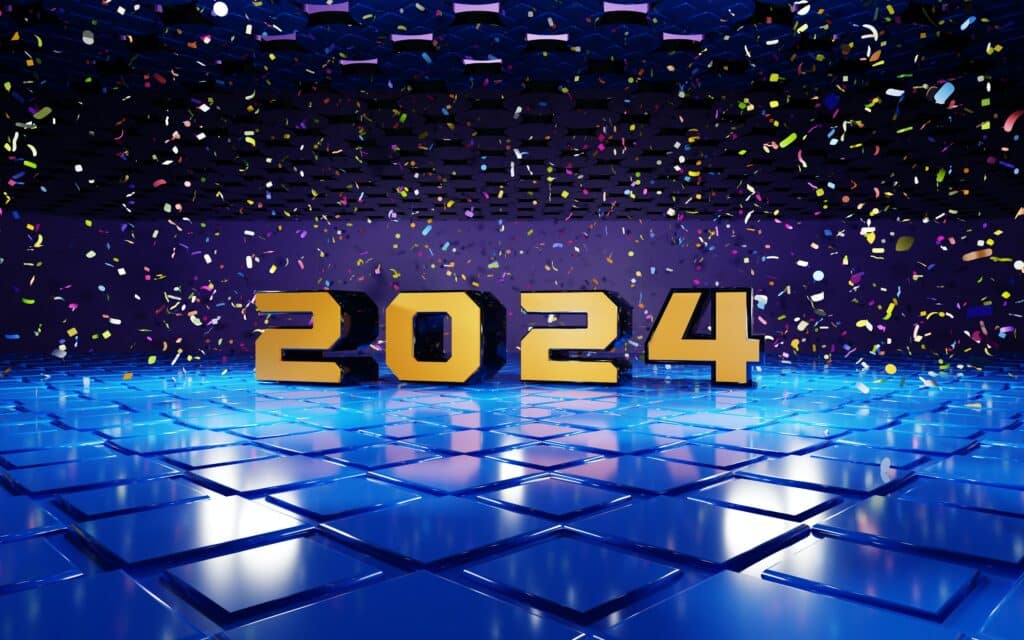
Yesterday, we took a look back. Today, we look ahead. As we near the end of 2023, we’ve already reminisced about the major coupon-related news stories of the past year. But what coupon-related news stories will we be talking about this time next year?
Predicting the future isn’t easy, and we won’t pretend to know all that’s going to happen in 2024. But there are several things we already know for sure will be happening in the new year, that you should know about and be prepared for. So as we say goodbye to 2023, here are some of the major stories that will be making news and impacting your couponing and shopping in 2024:
Addressing digital discrimination
The top story of 2023 could be just as big a story in 2024 as well. Four states are considering legislation to regulate grocery stores’ digital coupon programs, in an effort to make them more equitable and accessible to those without the means or the ability to load digital coupons.
New Jersey was the first to propose such legislation, and its bill is the closest to becoming law in 2024 – but lawmakers there will need to act fast. Assembly and Senate committees have advanced the state’s digital coupon bill to the full membership of both houses for final votes. But the state’s legislative session ends in less than two weeks. If the bill isn’t put up for a vote, or doesn’t pass both houses in time to make it to the governor’s desk for his signature, the measure is dead. And if its sponsors want to try again, they’ll have to start from scratch when the new two-year legislative session begins.
The initial version of New Jersey’s bill would have required a paper coupon equivalent for every digital coupon, so shoppers without access to digital coupons could still get the same discounts. The current version of the bill now calls for some type of in-store access to digital coupons, whether in the form of self-serve coupon kiosks or assistance from customer service employees. That version has proven to be somewhat more palatable to retail industry representatives, who argued that offering paper equivalents for every digital coupon just wouldn’t work.
But that hasn’t stopped New York, Illinois and Massachusetts legislators from introducing their own bills calling for paper coupon versions of each and every digital coupon. And each of those states is only at the midpoint of their two-year legislative sessions. Their digital coupon bills haven’t advanced as far as New Jersey’s, but they have more time. One, or some, or all of their bills could be considered in committees, be put up for a vote and become law in 2024.
Similarly, a member of Congress is leading an effort to look into the issue, which could result in federal regulation or legislation in the new year. So one way or another, this is an issue that coupon providers are going to have to grapple with in 2024, in figuring out a way to make their digital coupons more accessible – before lawmakers do it for them.
Decision on a major grocery merger
While it’s not directly coupon-related, this next topic is certainly of interest to couponers – and all grocery shoppers. We could be weeks away from finding out whether the country’s two largest traditional grocery chains will get the green light to become one – or whether their proposed merger will be stopped dead in its tracks.
Since announcing their planned tie-up more than a year ago, Kroger and Albertsons have spent 2023 talking up the benefits of a combined company. Greater efficiencies, greater strength to compete against Walmart, resulting in lower prices for shoppers. And it can all be accomplished without even closing any stores, as the retailers plan to eliminate any overlap by selling hundreds of stores to a competitor.
That’s Kroger and Albertsons’ argument, at least. It’s now up to federal regulators to consider whether that argument holds merit. There’s been plenty of skepticism about whether the deal will be better for the retailers and their shareholders than for shoppers and employees, as both lawmakers and consumers have expressed concerns. Now the U.S. Federal Trade Commission is due to weigh in, with a decision on whether to approve or block the deal expected by mid-January.
That decision will determine whether 2024 is the year that the Kroger-Albertsons combination turns into a contentious court battle, or a done deal. However things turn out, it will have a major impact on the grocery landscape as we know it next year, and for years to come.
A smaller grocery merger’s big impact
It’s hardly on the scale of a Kroger-Albertsons combination, and isn’t facing nearly as much skepticism or opposition, but the other big grocery merger in the works for 2024 is ALDI’s planned purchase of Winn-Dixie owner Southeastern Grocers, which the retailers expect to be finalized in the first half of the year.
And this one could have a more direct impact on couponers, since Winn-Dixie offers plenty of them, and ALDI does not. With many of the newly-acquired grocery stores due to be converted to ALDI after the merger is complete, shoppers who once couponed at Winn-Dixie won’t be clipping coupons at all anymore if their local store becomes an ALDI.
Of course, it’s not just couponers who will be affected. While ALDI expects to convert “a significant amount” of Winn-Dixie and Harveys stores to the ALDI format, it also says “a meaningful amount” will continue to operate as-is. And ALDI doesn’t have much experience operating full-scale supermarkets. Will these stores continue offering the same quality and selection of products? Will they have the same loyalty programs and coupon policies, which ALDI is generally unfamiliar with operating? And will ALDI be looking for even more acquisitions to grow even larger?
The Kroger-Albertsons merger plan is still up in the air. But without significant opposition brewing, the ALDI-Southeastern Grocers merger is all but a done deal for 2024 – and it could end up impacting grocery shoppers for years to come.
A restructured Rite Aid
Eight years ago, when Walgreens proposed buying Rite Aid, the drug store chain had more than 4,500 stores across the country. This year, when the retailer filed for bankruptcy, it had less than half as many. Today, it has about 1,800 – and it hopes to retain as many of them as possible in 2024.
As Rite Aid seeks to slim down and restructure its debt, a bankruptcy court will consider the retailer’s reorganization plan in the new year, which could determine how and whether the retailer is able to move forward.
Rite Aid was once one of couponers’ favorite stores, as they juggled the best drug store deals from the “big three.” For many, those days are long gone, as several states no longer have a single Rite Aid store at all. For those who do still have a Rite Aid nearby, the outcome of the retailer’s bankruptcy process could determine whether they’ll be able to take advantage of any Rite Aid deals in 2024 and beyond.
CVS cuts back
Speaking of drug store deals, they’ll be half as frequent in the new year at CVS. The ad that begins this coming Sunday will be valid for two weeks, after which most weekly circulars in 2024 will become biweekly circulars instead.
CVS had already cut back on its printed circulars a couple of years ago, ending their distribution by mail and scaling back their distribution in newspapers – the same path that other retailers have followed, including Kroger just this year. But going to every-other-week circulars, digital or otherwise, would make CVS one of the first major retailers to forego the regularity and predictability of weekly ads with different deals starting every Sunday.
CVS says the change “allows more time for customers to benefit from our store promotions.” Time will tell, whether it also means that deal-seeking customers will be visiting CVS half as often in 2024.
The end of coupon fraud
And finally, some good news – coupon fraud will end in 2024!
That, at least, was Inmar Intelligence’s vow back in 2021, when it unveiled a free tool for retailers allowing them to instantly determine the validity of a coupon as it’s scanned at the checkout. The tool, called CNFRM, represented “the company’s formal commitment to end coupon fraud by 2024,” Inmar declared.
Realistically, coupon fraud is unlikely to completely disappear within the next 12 months. But we’re certainly getting closer. Several retailers have since implemented other CNFRM-like systems to validate coupons – and catch counterfeits – on the spot as they’re scanned, instead of waiting for them to make their way through the system to get flagged in a far-off processing facility weeks or months later.
The Coupon Bureau’s universal digital coupon is meant to help combat coupon fraud as well. Last year at this time, the industry-backed group was planning for a large-scale launch of the new coupon format in early 2023. Now, its goal is to launch at several national and regional retailers in 2024.
The new format promises to be convenient for shoppers and resistant to fraud, if and when it finally becomes widespread. The promised nationwide launch may have been pushed back to 2024 – but no one ever said eliminating coupon fraud would be easy.
Here’s hoping couponing will be easy and fruitful for you in 2024. There will be changes, as there always are, but one thing will remain true in 2024 and for years to come – while the methods may change, saving money on your everyday purchases will never go out of style.
Image source: BoliviaInteligente on Unsplash
















Posted the below comments in the wrong online article
This is too much government intervention. It should be laissez faire in this case. How many people are you talking about without internet access or are digitally challenged? I see many seniors at my store using their smartphones and the kiosks to clip digital coupons. Eventually this law would be moot when almost every single person has a smartphone in the US and free internet access would be available just about everywhere.
In addition, the government wants to require a paper version of all these digitals, which would require an immense amount of paper, increase in costs and cutting down of trees to meet the needs of very small percentage of people. If the stores just offer a manner for customers to clip digital coupons via a kiosk or at customer service, that should be sufficient. In addition, most stores have free internet access if someone doesn’t want to use up his or her data to clip digitals.
If the government required paper coupons for each digital, companies would probably offer printable coupons thru their website, coupons.com or just cash back sites like Ibotta and not even offer it digitally. Lidl doesn’t even accept manufacturer’s coupons, only their own digital coupon on the app which is automatically clipped.
Poor people have issues with getting and keeping connectivity. Even those free services have limits. And kids tend to use that up. You have obviously never been destitute, and good for you, but some of.us have and access to coupons would help. In fact it did for me.